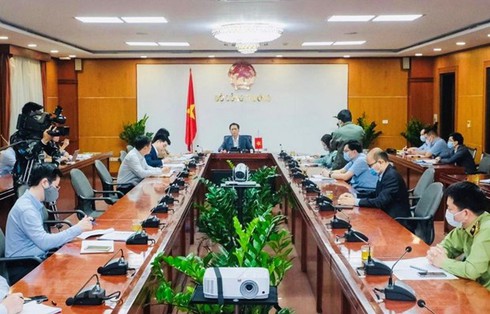to identify measures aimed at addressing the growing backlog of Vietnamese exports at border areas since the beginning of this month.
 |
|
The phone talks are held on April 17 (Photo: VNA)
|
The talks were part of the efforts to maintain trade between the two neighbours amid COVID-19.
The officials agreed to enhance cooperation and create favourable conditions for bilateral trade, therefore assisting the two countries’ business communities now and in the immediate future.
Ni and Zhong pledged to direct local authorities and customs units at the Tan Thanh - Po Chai border gate to ease the congestion of goods.
Customs clearance will resume and be available daily from 8am to 11am and 12pm to 4pm (Vietnam time).
The Chinese side suggested simplifying inspection procedures on farm produce, transferring goods to other border gates, and increasing the importation of farm produce via Pingxiang - Dong Dang railway station.
In order to boost the export of Vietnamese farm produce to China, Minister Anh proposed the General Administration of Customs and Ministry of Commerce of China soon approve new border gates designated for fruit, food, and fisheries imports, allow the Pingxiang - Dong Dang railway station to import more types of farm produce, and for several Vietnamese types of farm produce to enter China via official channels, such as grass jelly, swift nest products, sweet potatoe, and durian, which are awaiting final legal procedures.
The minister also called on China to quickly complete legal procedures to allow the import of Vietnamese passion fruit, avocado, pomelo, coconut, custard apple, and water apple, as well as permit more Vietnamese enterprises to export to the country.
He also suggested extending the validity of the list of fish powder exporters and restoring the export status of several rice and fisheries enterprises.
Both sides discussed measures to facilitate trade on the back of Industry 4.0 and reached consensus on online trade promotion activities.
They vowed to create favourable conditions for businesses in the fields of machinery, equipment, fabric, footwear, and electronic spare parts, thus ensuring supply chains and domestic production.
The officials also debated post-pandemic action plans to support bilateral trade and businesses as well as the signing of an MoU on cooperation between Vietnam’s Ministry of Industry and Trade and China’s General Administration of Customs, and agreed to an inter-sectoral cooperation programme to simplify customs clearance procedures and prevent trade fraud.
Since late March the Ministry of Industry and Trade has actively contacted authorities in Guangxi and Yunnan provinces to ensure smooth trade between both sides.
Vietnamese, Japanese trade ministers hold phone talks
Minister of Industry and Trade Tran Tuan Anh and Japanese Minister of Economy, Trade and Industry Kajiyama Hiroshi on April 17 agreed to assign units concerned to continue discussing the ASEAN – Japan action plan to restore economic growth.
During their phone talks, they also vowed to help the two countries’ businesses cope with COVID-19, as well as strengthen regional and global supply chains.
Anh informed Hiroshi of the ASEAN’s common stance on the draft joint statement of ASEAN and Japanese economic ministers on strengthening economic resilience in response to the outbreak of the COVID-19, which will be built on the basis of major contents in the Joint Statement proposed by Vietnam and adopted by ASEAN economic ministers at the 26th ASEAN Economic Ministers’ Retreat in the central city of Da Nang on March 10.
They also agreed in principle that ASEAN and Japan will issue the joint statement next week.
At the online Special ASEAN 3 Summit on Response to COVID-19 on April 14, leaders of ASEAN member states and China, Japan and the Republic of Korea adopted a joint statement to promptly respond to the pandemic’s impact on people’s health, and ease its socio-economic tolls in the region and the world. VNA
 Minister of Industry and Trade Tran Tuan Anh held phone talks with Director of China’s General Administration of Customs Ni Yuefeng and Minister of Commerce Zhong Shan on April 17
Minister of Industry and Trade Tran Tuan Anh held phone talks with Director of China’s General Administration of Customs Ni Yuefeng and Minister of Commerce Zhong Shan on April 17